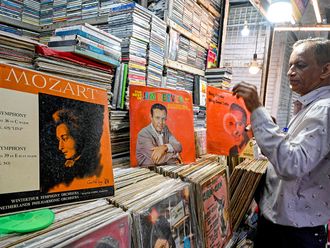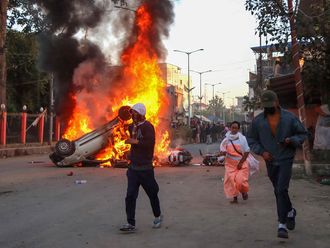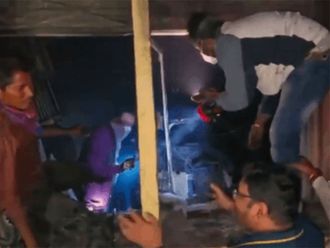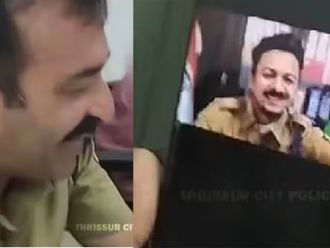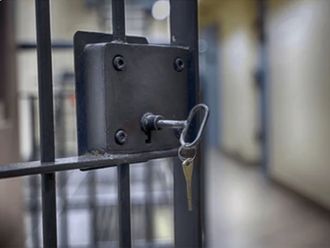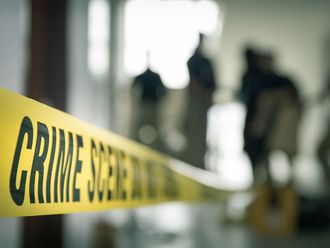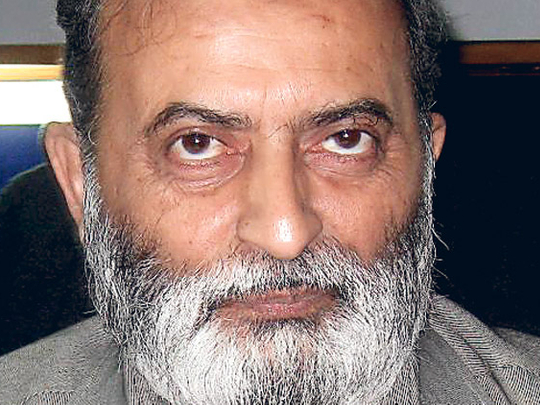
Lucknow: People across the country are anxiously waiting for a high court in the northern city of Lucknow to deliver the verdict in a century-old religious dispute that has never entirely gone off the boil.
Around 6,000 people have died since December 6, 1992 when a mob of Hindu right-wing activists destroyed a sixteenth century mosque popularly known as Babri Masjid in Ayodhya, around 120 km from Lucknow, on December 6 that year triggering a wave of communal violence across the country.
The razed mosque is believed to have been built by Mughal emperor Babur’s lieutenant Mir Baqi in 1528. Hindu activists contend that the mosque was built after destroying a temple that stood on the spot. They also assert that the very spot where the mosque once stood is the birthplace of Ram, a Hindu deity worshipped by millions.
Zafaryab Jilani, 60, leads a team of a dozen lawyers who represents members of the Muslim community in the high court. Legal proceedings in the case have been ongoing since 1986. Prior to that, the case was being heard in a district court.
Jilani is also the convener of All India Babri Masjid Action Committee, a Muslim organisation fighting for the restoration of the mosque.
In an exclusive interview with Gulf News at his modest office in the basement of the century-old Islamiya College in Lucknow, Jilani spoke at length on the mosque-temple issue, discussed his post-verdict strategy and explained why the Muslims of India have fought this messy and painfully long battle to reclaim a 2.71-acre plot of land where the mosque once stood.
Jilani is soft-spoken, yet capable of delivering a razor-sharp argument. He can also reel off historical and legal facts pertaining to the case with equal ease. After topping his law class in Aligarh Muslim University, Jilani took up practice as a full-time lawyer. He has been handling the Babri Masjid case since 1986. Wearing an old-fashioned safari suit and a salt-pepper beard, this man can be easily mistaken for a government clerk who is counting his days to retirement.
Excerpts from the interview:
Gulf News: What is the case in the high court about?
Jilani: The mosque was said to be constructed during the regime of Babur in 1528 and it was casually known as Babri mosque. On the night of December 23, 1949, some Hindus planted statues of Ram and his brother Laxman inside the middle dome of the mosque.
The police first tried to control the situation by attaching [legal jargon for locking up the property] the mosque. Soon after, the then prime minister Jawaharl Lal Nehru ordered the removal of the statues but Ayodhya’s then district magistrate declined to follow the instruction citing the law-and-order situation in the city. On January 16, 1950 a lawsuit was filed in the district court by Gopal Singh Vishrat, a resident of Ayodhya. The lawsuit claimed that Hindus had been worshipping the idols at the mosque for a long time and accused the officials of conniving with Muslims to remove the statues. The court was urged to restrain the officials from removing the statues. The Muslims prayed in the mosque till December 22, 1949. The state government had then assured Muslims that the lawsuit filed by Vishrat would be dismissed and categorically submitted in the court that the building had never been a temple and was always a Muslim place of worship.
Another case was subsequently filed by a Hindu priest pleading with the court to allow worshipping of statues inside the mosque the same year. As the the two cases lingered on, a Hindu group, Nirmohi Akhara, that owned a courtyard outside the mosque since 1885, filed the third case in 1959 demanding that the mosque be handed over to them.
All the three suits demanded permission to worship the statues inside the mosque but did not ask for the construction of a temple. Also, they never claimed that there was a temple at the mosque site.
Twelve years after the first suit was filed, eight Muslims and Sunni Waqf Board, a body that manages Muslim religious buildings in India, jointly filed a suit in 1961 demanding that the structure be officialy declared a mosque and that Muslims be given possession after removing the statues. The Waqf Board waited for 12 years thinking that the Hindus’ case would be dismissed by the court. The four cases lingered on till 1986.
That year, under a conspiracy to please Hindus, the Congress party government ordered the opening of the locks of the mosque and allowed Hindus to worship the idols. This incident flared up the dispute and Muslims demanded immediate settlement of the court cases. The government then pleaded to shift all the cases to a high court bench in Lucknow so that they could be expedited. The high court began hearing the case in 1989. A Hindu organisation, the Vishwa Hindu Parishad (VHP), filed a case in the high court in 1989 The VHP suit, filed on behalf of the Hindu deity Ram, sought the demolition of the mosque and construction of a temple. The organisation succeeded in destroying the mosque in 1992. Meanwhile, the case filed by a Hindu priest in 1959 was withdrawn in 1990. Now the high court will decide on the other four cases.
Gulf News: Has the court taken cognisance of the Archaeological Survery of India (ASI) report that surveyed the mosque site?
Jilani: The court has taken cognisance of the report but we believe that the ASI findings are defective. The ASI simply says that there was a 12th century structure of a non-residential building under the mosque. The ASI found a wall built in two phases — first pre-12th century and subsequently in the 12th or 13th century. We have argued that 1190 AD was the begining of Muslim period in Ayodhya and the Muslim kingdom was established in 1206 and the Hindu kingdom ended in 1196.
So if we believe that this wall can’t be of any temple... who would have built a temple then. We have argued that this could be the wall of an Eidgah. No statue was found at the site. All the structures found by the ASI were either at the surface or from the debris (of the destroyed mosque). Under the Indian archaelogy laws, no period can be attached to anything found on the surface or in form of debris. The ASI, however, contended that the structure resembled a 12th century Hindu temple but refrained from categorically describing it as a temple. The ASI said it was a non-residential structure. The ASI also found some animal bones and we believe that there is no place for bones in a Hindu temple. Our archaeologists who were produced in the court as witneseses on behalf of Muslims testified that the bones belonged to animals that were eaten by humans. All these archaeologists who testified from our side were Hindus. The ASI is silent on the bones.
Gulf News: What are you fighting for?
Jilani: We say that this building was never a temple. The Babri mosque was not constructed after demolishing any temple. And this is not the birth place of Ram.
Gulf News: How can you say so?
Jilani: Because the Hindus themselves never believed this to be Ram’s birthsite till the 19th century. In 1885, the head priest of Janmsthan [Ram’s birthplace] filed a suit. Janmsthan refers to an elevated courtyard located in the outer portion of the mosque.
In a site plan filed along with that suit, the Hindu priest identified the building as a mosque. This document is still available in court records. This is one of the most important pieces of evidence produced by us proving that till 1885 Hindus did not call the mosque as the birth place of Ram. During the hearing of that case in 1886, a judge visited the site and he said it was very unfortunate that the mosque was construcetd in that spot but added that Hindus believed that an elevated courtyard outside the mosque was the birthplace of Ram. In 1941, two rival Hindu priests of a group known as Nirmohi Akhara went to court against each other over a property dispute. They also identified the Nirmohi Akhara property as the birthplace of Ram. Papers submitted by the two showed the mosque on the west side of the property. So up to 1941, Hindus never claimed that Ram’s birthplace was located at the mosque site.
Gulf News: So why then was the Babri mosque also known as Masjid-e-Janmsthan?
Jilani: Because a Janmsthan temple was located on the northern side of the mosque [now it falls in the disputed area aquired by the government]. So now, according to Hindu activists, there are three sites linked to Ram’s birth: the first one at the site identified by a Hindu priest in 1885, second one claimed by the two fighting priests of Nirmohi Akhara and the third at the present dispute site where Babri mosque once stood. In 1864, the then Director General of the Archaeological Survey of India submitted a report identiying the temple as the Janmsthan.
So we don’t dispute the birth of Ram in Ayodhya but the Hindu activists have to prove that Ram was born at the very spot where the mosque once stood.
Gulf News: Even if the high court believes that what you are saying is correct, what exactly are you trying to achieve? The mosque now stands demolished and a reconstruction is impossible?
Jilani: It is not a question of the reconstruction of the mosque. It is the question of assertion of our [Muslims] right. Should we lose the right merely because they [Hindus] are in majority?
Gulf News: What if this is in the best interest of the country?
Jilani: No this is not in the best interest of the country. The persons who have done this [destruction of Babri mosque] are not the true representatives of the country. Our country is a secular country. So the majority of Hindus are not with them [who are demanding a temple]. It is also not the question of the will of the majority [community]. It is only a section of the majority community [Hindus] who want to treat Muslims as second-class citizens. And we are not prepared to be treated in that way and so we have to naturally resist these attempts. It is also not about seeking the goodwill of the majority community. The majority of Hindus do not want that this mosque should be converted into a temple.
Gulf News: What will happen next if you manage to prove that no temple existed before the mosque was built in 1527?
Jilani: Then the high court will declare that, yes, this is a mosque and not a temple.
Gulf News: Do you think that the court will be so categoricall?
Jilani: There are some issues before the high court. There is a practice in India that court findings are recorded on the basis of issues placed before the court. The specific issue is whether the disputed site is the birth place of Ram, whether the mosque was built after demolishing a temple, and whether this site was always a temple as claimed by the Hindu activists.
Gulf News: But how can the high court decide that?
Jilani: The burden of proof is upon the Hindu activists.
Gulf News: So what happens next?
Jilani: Once the [court] declaration is there that this is not a temple... the high court perhaps may not say that Ram was not born there. But the high court can say that they [Hindu activists] have not been able to prove it.
Gulf News: And then?
Jilani: The efforts of those who are trying to construct a temple at the site will be jeopardised. They will have to challenge the high court order in the Supreme Court. And if the Supreme Court upholds the high court order, they will never be able to construct a temple.
Gulf News: Is this your objective?
Jilani: Off course. No temple should be constructed on the site of a mosque. This is our sole objective. This is our main objective and the reconcstruction of the mosque is the second objective? Our future generations should not feel that this was our mosque and it was taken away.
Gulf News: Why do you think this mosque is so important to Indian Muslims?
Jilani: It is not a question of being important or not. It is a question of a case where they have forcibly demolished a mosque. Their act challenged India’s constitution and the judiciary. And if we do not resist them, no one will be able to do so. We are resisting because this country can not be governed by rule of the jungle. This country will only be governed by the rule of law. And the rule of law says status quo has to be maintained at the disputed site. The 150,000 odd people who demolished the mosque in 1992, destroyed the secular fabric of the Indian constitution.
This is what we are fighting for. We are not fighting just for the structure.
Gulf News: Who exactly are you representing in the court?
Jilani: Sunni Waqf Board, Mohammad Hashim [a petitioner in the case] and others. We are not representing Muslim Personal Law Board or the All India Babri Masjid Action Committee. They are not part of the case. But the parties involved in the case are no different from the Muslim community itself. Here, the will of the community is represented by these parties. My assertions in the court reflect that of the community.
Gulf News: But do these organisations which you represent the true voice of the Muslim community?
Jilani: I challenge anybody to hold a refrendum in any city of India and take people’s opinion on whether the mosque should be preserved or not. Thereforce, I can say with confidence that we represent the will of the Indian Muslims.
Gulf News: What if the verdict goes against you?
Jilani: We will approach the Supreme Court. In the Supreme Court it can be decided within a year or it can take even ten years.
Gulf News: What if the Supreme Court also rules against you?
Jilani: We will fight till the end legally. We know that the Supreme Court verdict will be accepted by the country.
Gulf News: But if the Supreme Court decides in your favour do you think the government of the day will have the political will to implement it?
Jilani: You are confusing two things. Firstly, the Hindu activists will not be able to do anything at the site.
Gulf News: But the government can always bring a law if the court verdict goes against Hindu activists?
Jilani: The government cannot. In India, parliament is not competent to undo the judgments of the Supreme Court. This is our considered opinion. But if they bring a law, we will challenge it in the Supreme Court.
Gulf News: Who do you think was responsible for the demolition of the mosque?
Jilani: Firstly, this responsibility falls on the Hindu right wing organisations like Rashtriya Swayamsewak Sangh and BJP. Secondly, it falls on the state government which was directly in charge of the disputed site but permitted the gathering of Hindu activists in 1992. Thirdly, former prime minister P.V. Narasimha Rao is responsible for failing to intervene when the mosque was being demolished.
Gulf News: You held a meeting with the former prime minister two days before the mosque’s demolition?
Jilani: We met Rao around November 15, 1992 at his residence in New Delhi. When we raised our concerns about the planned gathering on December 6, Narasimha Rao told us: “Look here you are talking with the prime minister of the country. I can send troops to a neighbouring country in six hours. Why do you think Ayodhya is beyond our country. You are talking to the prime minister and the prime minister can do anything?
Gulf News: Were no minutes taken of this meeting?
Jilani: There was no practice of taking minutes in India. Whenever we met the prime minister, we never got the minutes.
Gulf News: Do you think any political party has seriously tried to resolve this issue?
Jilani: Some persons did try. Former prime minister Chandrashekhar did try. But when Chandrashekhar found out that the Hindu organisations were not willing to budge even an inch from their stated positions, he became silent. VHP and RSS want Muslims to simply surrender the site.
Gulf News: Don’t you think the Muslims, as a goodwill gesture, can hand over this land to the Hindus in view of such strong sentiments?
Jilani: First of all, it is not permissible under Sharia to hand over a mosque to build any other structure. But even if we consider the handover of the mosque for the sake of peaceful co-existence of Hindus and Muslims, we can not trust that this will not become a precedence for other mosques in India. Once we surrender a mosque, the floodgates will open as the hardliners among Hindus claim that close to 33,000 mosques were built after destroying temples. And this includes New Delhi’s Grand Mosque.
Gulf News: Where do you get your funds from?
Jilani: There is no funding. We launched the All India Masjid Action Committee in 1986 and until 1992 we collected only Rs100,000. From 1992, this legal battle was funded by the Muslim Personal Law Board. So far the board has collected around Rs1.5 million mainly from Kerala and Karnataka states. The legal team is not charging any fees.
Gulf News: How do you manage your cases?
Jilani: I handle other court cases. I am a full-time civil and criminal lawyer.
Gulf News: Is there a chance of any kind of out-of-court settlement after the verdict? What are the conditions required for any kind of settlement?
Jilani: It is very difficult. So far as the mosque is concerned, Muslims can not surrender. The Muslim Personal Law Board members comprising religious scholars is firmly of the view that the mosque can not be surrendered. But we can have some kind of negotiations after the verdict.
Gulf News: No government has the courage to try and influence the Hindu organisations on this issue. The political risk is too high? But they definitely see scope for some kind of negotiations with Muslims.
Jilani: No government has the courage to influence us. We are not so weak that we can be persuaded by any government. It is the question of our existence in this country and our constitutional rights. So long as India is a secular state, so long as we have equal rights, nobody can influence us.
Gulf News: Do you strongly believe in the secular credentials of Indian institutions?
Jilani: A large majority of Hindus are secular. All the senior lawyers who are fighting the case for Muslims in the Supreme Court are Hindus and they have never charged any fee from us.


